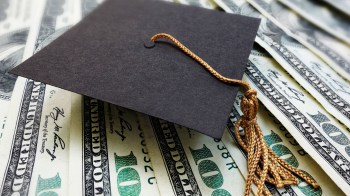
No interest, no payments required on federal student loans until 2021

It’s official: if you have federally held student loans, you don’t have to make any payments until January.
Following a memorandum from President Donald Trump, the Department of Education says it will automatically extend the suspension of student loan payments for everyone with federally held student loans through the end of the year, and keep the interest rate at 0%. While payments are paused, those working toward Public Service Loan Forgiveness or loan rehabilitation will also continue to get credit as if they were making payments, and collection efforts will remain suspended for borrowers who are in default.
That temporary relief, which has been in place since the CARES Act passed in March, had been set to expire at the end of September.
What does this mean for my student loans?
Payments on all federally held student loans will remain suspended through Dec. 31. The interest rate for all qualifying loans will also remain at 0% through the end of the year.
“The payment pause and interest waiver is essentially freezing your loans in time,” said Mark Kantrowitz, publisher and vice president of research at SavingforCollege.com.
Unless you choose to continue making payments voluntarily, your balance will be the same at the end of December as it was in March.
Do my loans qualify for this temporary relief?
This relief only applies to loans that are both federal and federally held, meaning your lender is the federal government, and not a bank or other commercial lender.
So which loans qualify?
— All direct loans qualify. This includes all federal loans taken out since 2010, as well as direct Parent PLUS loans.
— Most Federal Family Education Loan Program or FFEL loans — those taken out before 2010 — do not qualify. There are some exceptions.
— Most Perkins loans — held by a college or university — do not qualify. There are some exceptions here too.
Those exceptions are for the 10 or so percent of FFEL loans — and the handful of Perkins loans — that the Department of Education bought back from other lenders during the recession. Those qualify.
“If you have a direct loan, you don’t have to ask any more questions. Your loans are eligible for these waivers,” said Betsy Mayotte, president of The Institute of Student Loan Advisors. If you have a FFEL or Perkins loan, and “you’re in the lucky minority where your loans were purchased by the Department of Education at some point, then it’s possible that your FFEL or Perkins loans could also be eligible for these waivers.”
If you’re not sure what kind of loan you have, you can ask your servicer or log in to StudentAid.gov and look at your lender.
“If the lender is showing as Department of Education, then it’s federally held and it would be eligible for the waivers,” Mayotte said. “But if it’s showing, say, AES or Chase Bank or Sallie Mae, then it’s not a federally held federal loan. It’s still a federal loan, but it’s not considered a loan that’s eligible for the waivers.”
My loan has been on pause since March. Do I have to do anything to get this extended relief?
No. It will happen automatically, you don’t have to ask. If you haven’t heard from your servicer yet, don’t worry.
The Department of Education says “borrowers can expect to see this extension reflected in their accounts over the next several weeks.”
My loan does not qualify. Do I have any options?
Yes. What those options are depends on what kind of loans you have, and on your financial situation.
If you have federal loans and you’ve recently lost work, the first thing to do is apply for an income based repayment plan if you’re not already in one, or recertify your income if you are.
“For those not in default,” Mayotte said, “if their income has been significantly reduced, it’s possible they could qualify for a zero dollar payment.”
If that doesn’t apply to you, you can call your lender and ask for a forbearance or an economic hardship deferment.
Another option, Kantrowitz said, is if you have ineligible FFEL or Perkins loans, “you can convert these into eligible loans by consolidating them.”
There are things to consider before you do that — primarily that consolidating might reset the clock on any loan forgiveness plan you’ve been working toward. But if you think you might want to do it, Kantrowitz recommends looking into it now, because loan consolidations can take some time to process. And for now at least, the pause on student loan payments and interest only lasts until the end of December.
If you have private student loans, your best option is to call your lender.
“I do know that many lenders are trying to be as flexible as possible during this sort of weird time that we’re in,” Mayotte said. “So absolutely make the call rather than just going radio silent and letting the loan negatively affect your credit.”
What if I’m pursuing Public Service Loan Forgiveness? Do I need to keep paying?
No. If you’re working toward PSLF, the Department of Education has said this time will count toward your 120 qualifying payments, even if you don’t pay a dime — as long as you’re still working full-time for an eligible employer.
“The great news,” Mayotte said, “is they’re going to treat this period of time like you were actually making payments.”
Given that, there is no incentive for you to make payments right now, according to Kantrowitz. “If you make extra payments, it’s going to reduce the amount of your forgiveness.”
What if I’m in default?
All collection efforts are on pause until Dec. 31. That includes wage garnishment and tax and Social Security offsets.
If you’re currently pursuing a loan rehabilitation program, you do not have to continue making rehabilitation payments. You will still get credit for these months as if you had been paying.
“It’s great,” Mayotte said. “You’re not going to have to wait any longer to rehabilitate your loan just because of these waivers.”
I still have a job and can afford to keep making payments. Should I?
It depends on your circumstances.
“There’s no one blanket answer,” Mayotte said.
Both she and Kantrowitz recommend tackling your highest interest debt — maybe that’s a credit card, or a car loan — and building up your savings first. Particularly given that no one knows how long the pandemic, and the ensuing economic fallout, will last.
“I’m advising people to build an even more robust emergency fund than what historically we’ve tended to advise people to keep on hand,” Mayotte said. “I would recommend these days for someone to have a year’s worth of expenses in an emergency fund, which is a lot. But again, we don’t know what the long term economic impact is going to be yet.”
But if you don’t have other debt, and you have a solid emergency fund? Then, Kantrowitz said, “I would throw every dollar you can at that zero percent loan.”
Because for once, you won’t be battling interest, and you’ll just be chipping away at the principal.
“For those people,” Mayotte said, “I would call that a gift.”
Where can I get more information?
— StudentPandemicAid.org is a free, regularly updated guide for anyone with student loans who’s been affected by the pandemic and is looking to understand their options. It’s a partnership between TISLA, Mapping Your Future and Decision Partners.
— The Consumer Financial Protection Bureau has this FAQ on navigating student loans during the pandemic.
— StudentAid.gov, from the U.S. Department of Education, has this information page for students, borrowers and families. Here, too, you can log in and check your lender.
— The Student Borrower Protection Center has a webinar on student loan repayment options and lists of both state and federal resources.
There’s a lot happening in the world. Through it all, Marketplace is here for you.
You rely on Marketplace to break down the world’s events and tell you how it affects you in a fact-based, approachable way. We rely on your financial support to keep making that possible.
Your donation today powers the independent journalism that you rely on. For just $5/month, you can help sustain Marketplace so we can keep reporting on the things that matter to you.


















